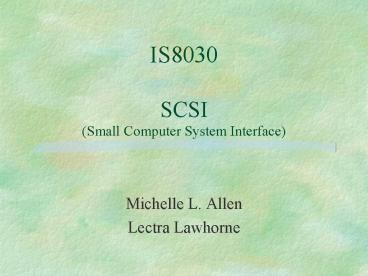IS8030 SCSI Small Computer System Interface - PowerPoint PPT Presentation
1 / 10
Title:
IS8030 SCSI Small Computer System Interface
Description:
Developed to meet needs for a flexible, faster interface ... but it's really no more complicated than choosing master/slave jumpers in IDE. ... – PowerPoint PPT presentation
Number of Views:666
Avg rating:3.0/5.0
Title: IS8030 SCSI Small Computer System Interface
1
IS8030SCSI(Small Computer System Interface)
- Michelle L. Allen
- Lectra Lawhorne
2
OUTLINE
- Introduction
- Evolution
- Unique Features
- Specifications
- Pros of SCSI
- Cons of SCSI
- Conclusion
3
INTRODUCTION
- Developed to meet needs for a flexible, faster
interface - Provides the medium between PCs and peripheral
devices - Unlike other interfaces (IDE for example)
- it consists of a separate
- bus provided through the
- host adapter thus
- eliminating bottlenecks
- on system resources
4
EVOLUTION
- 1979 Shugart started developing a new universal
interface to use logical addressing instead of
head/cylinder/sector addressing - 1981 Presented to ANSI and the project was
named SCSI - 1984/1985 Designers presented the draft
proposal for approval - 1986 SCSI-1 became official
- Apple Computer was one of the first to use SCSI
as a key component of Mac computers - Adoption of SCSI slow to start due to
- legacy systems and resistance to change
- Manufacturers were hesitant to adopt due to cost
and effort to create - Manufacturers feared the technology might become
obsolete
5
EVOLUTION (Cont.)
- SCSI is ever-evolving
- Family of different standards that build on each
other(SCSI-1, SCSI-2, SCSI3, Fast SCSI,
Fast/Wide SCSI, Ultra SCSI, Wide Ultra SCSI,
Ultra2 SCSI, Wide Ultra2 SCSI, and more) - SCSI-1 addressed only the physical and electrical
specifications - need for a common set of
commands so the different manufacturers hardware
could work collectively - CCS (Common Command Set) developed
- Manufacturers claimed devices SCSI-2 compliant
but were not proved that SCSI-1 works with
SCSI-2
6
UNIQUE FEATURES
- Separate bus that is attached to system bus
through an adapter - Built in controller interprets demands
- CPU and system bus demands for devices are done
through interaction with the host adapter - Adapter handled the commands leaving and does not
utilize the CPU - Only the adapter takes up a system IRQ instead of
each device (better scalability) - Each device can support 8 devices thus
improving scalability (though devices are not
taking advantage of this yet) - Command queuing Can send 256 commands on bus to
SCSI device - The device can process commands in any order it
desires - Frees bus for other devices and commands
7
SPECIFICATIONS
- Initiators are devices that request I/O processes
and targets are those devices that perform the
actions requested by the initiator. - Each device attached to the SCSI bus may be an
initiator and the bus is only used for
transmitting data and commands - The transfer of data and commands occurs in eight
phases - Bus-Free Checks if bus is free to use
- Arbitration Bus placed in busy state higher ID
wins in contention - Selection Target states it is active too,
remembers initiator for broken connections - Command 4 -7 share the data commands
- Data also termed Data In about connection and
status - Message also termed Data Out information for
each device - Status
- At completion the initiator will reset the bus
control signal to a ready state - During selection an intentional or error break
can occur an intentional would be for memory
access which is time consuming so it frees the
bus for utilization
8
PROS of SCSI
- Flexible device attachment (7 or 15 devices per
SCSI bus) - Longer cable lengths allowed (up to 12 meters)
- Support for almost any peripheral device (disks,
tape, CDROM, optical, scanner, etc.) - Interface and protocol is carefully specified by
ANSI, and maintains high performance standards - Most adapters can do scatter/gather DMA which is
a necessity in virtual memory systems (like Unix,
NT, 2000) - Development cycles for SCSI devices is very
short, thus the latest generation of SCSI
peripherals keeps pace with the latest generation
of computer systems - The intelligent interface places commands onto
the SCSI device, thus freeing the CPU for other
tasks. (IDE takes up to 95 of the CPU during
data transfers, while SCSI only uses about 5 of
the CPU for buffer management.) - Extends concept of multitasking to peripheral
devices
9
CONS of SCSI
- Generally more expensive, due to more complex
firmware, extra testing is required, and
increased performance typically costs more in the
computer market. - Slightly more complicated to install, due to
termination requirements and if one uses multiple
buses. - Terminology and connection protocol options are
overwhelming. - Some people point to the need to set IDs in SCSI
as making it more complicated, but it's really no
more complicated than choosing master/slave
jumpers in IDE.
10
CONCLUSION
- The SCSI interface is complex yet very versatile
- Its increased scalability and increased speed
will allow for computers to attach more devices - With its separation from the main system's bus
and CPU it provides a unique and excellent
solution to limited system resources - Even though other interfaces are still used,
SCSI's benefits will increase its popularity - Its constant evolution and development is a
testament to its effectiveness.































